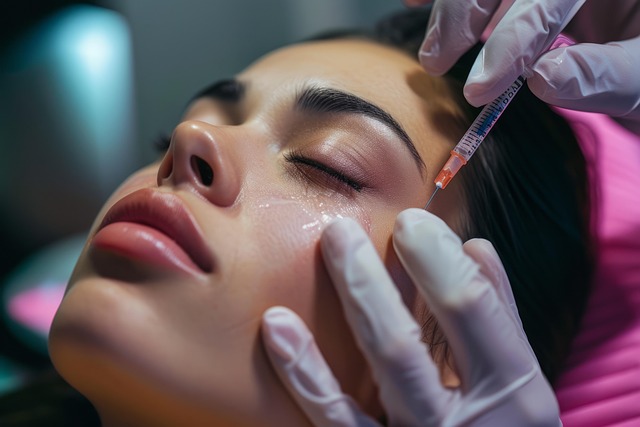Frown wrinkles ("11s") are addressed by Botox and dermal fillers, which target dynamic wrinkles and volume loss respectively. Botox paralyzes muscles for preventing wrinkling, while dermal fillers enhance skin volume with hyaluronic acid or collagen. The choice between them depends on individual needs, budget, and desired outcome. Botox is ideal for subtle correction and preventing fine lines, whereas dermal fillers offer more dramatic results for deeper wrinkles. Understanding these differences is vital for selecting the most suitable treatment to achieve a youthful appearance.
Tired of frown lines deepening your expression? Discover the power of Botox as a game-changer in smoothening frown wrinkles. This article explores the science behind frown wrinkle formation and why Botox has emerged as a leading treatment. We delve into how Botox relaxes muscles, compares its effectiveness to dermal fillers, and highlights its safety profile. Learn about tailored treatment plans, considering Botox vs dermal fillers, to achieve the desired look you crave.
Understanding Frown Wrinkles and Their Causes

Frown wrinkles, also known as glabellar lines or “11s,” are a common concern for many individuals seeking to maintain a youthful appearance. These vertical creases between the eyebrows can form due to various factors, primarily involving muscle movement and age-related changes in the skin. Understanding these causes is crucial when considering treatments like Botox or dermal fillers.
While both Botox and dermal fillers are popular options for reducing facial wrinkles, they target different aspects of the aging process. Botox, a protein derived from bacteria, works by temporarily paralyzing the muscles that cause frown lines. This non-invasive procedure smooths out wrinkles and prevents their formation. On the other hand, dermal fillers enhance volume loss over time by injecting hyaluronic acid or collagen into the skin. They provide immediate results but may not offer the same degree of muscle relaxation as Botox.
The Role of Botox in Treating Frown Lines

Botox has emerged as a popular and effective solution for treating frown lines and wrinkles, offering a non-surgical alternative to dermal fillers. Unlike dermal fillers that plump and enhance the skin’s surface, Botox works by relaxing the muscles responsible for causing dynamic wrinkling. By blocking nerve signals to these muscles, Botox prevents them from contracting, thereby reducing the appearance of frown lines and crow’s feet.
When it comes to choosing between Botox and dermal fillers, understanding the differences is key. Dermal fillers are ideal for addressing volume loss and enhancing specific areas, while Botox is better suited for preventing or minimizing dynamic wrinkles caused by muscle contraction. Many individuals opt for a combination of both treatments for comprehensive facial rejuvenation, leveraging each method’s unique benefits to achieve their desired aesthetic results.
How Dermal Fillers Compare to Botox for Wrinkle Reduction

When it comes to combating frown wrinkles, both Botox and dermal fillers are popular choices. However, understanding their differences is crucial for making an informed decision. Botox is a neurotoxin that relaxes muscles, preventing contraction and thus reducing dynamic wrinkling, especially around the eyes and mouth. It’s ideal for fine lines and crow’s feet but requires repeated treatments every 3-6 months.
Dermal fillers, on the other hand, are made of hyaluronic acid or collagen and add volume to the skin by filling in depressed areas. They offer more dramatic results than Botox, enhancing facial contours and smoothing deeper wrinkles. Fillers last longer, typically between 6-18 months, but aren’t as effective for preventing new wrinkles from forming. The choice between Botox vs dermal fillers ultimately depends on individual preferences, budget, and desired outcome.
Benefits of Botox for Targeted Muscle Relaxation

Botox has emerged as a popular and effective solution for reducing frown wrinkles, offering several advantages over traditional dermal fillers. One of its key benefits is targeted muscle relaxation. By injecting a small amount of Botox into specific muscles responsible for facial expressions, such as the corrugator supercilli and procerus, it temporarily paralyses these muscles. This action prevents them from contracting and causing deep wrinkles between the eyebrows and on the forehead, thereby achieving a smoother and more youthful appearance.
Unlike dermal fillers that add volume to the skin, Botox focuses on relaxing the overactive muscles, making it ideal for individuals seeking a subtle yet effective treatment. This approach not only provides immediate results but also offers long-lasting effects, often lasting 3-6 months, making it a convenient and cost-effective option compared to repeated filler injections. Moreover, Botox is generally well-tolerated with minimal downtime, making it an attractive choice for those considering non-surgical aesthetic procedures.
Safety and Effectiveness Considerations: What to Expect

When considering Botox for frown wrinkles, it’s crucial to understand safety and effectiveness. Unlike dermal fillers, which add volume by injecting a substance under the skin, Botox works by relaxing muscles that cause frowning. This results in smoother lines rather than plumping up the area. Both treatments have their merits, but Botox offers a more targeted approach, making it a preferred choice for specific muscle-related wrinkles.
Expect some minor side effects, such as temporary redness or swelling at the injection site, which typically subside within a few days. It’s important to choose a qualified provider who can ensure proper technique and minimize these risks. In comparison to dermal fillers, Botox offers a subtler result, making it ideal for those seeking to reduce fine lines and prevent more pronounced wrinkles from developing.
Choosing the Right Treatment Plan: Botox vs Dermal Fillers

When considering treatments for frown wrinkles, understanding the differences between Botox and dermal fillers is key. Both are popular options in the skincare world, but they work in distinct ways. Botox is a neurotoxin that relaxes muscles, preventing contractions that cause wrinkling. It’s ideal for dynamic wrinkles, those that form when you smile or frown. On the other hand, dermal fillers are made of hyaluronic acid or collagen and add volume to the skin by filling in depressed areas. They’re best suited for static wrinkles, which are present even when your face is at rest.
The choice between Botox and dermal fillers depends on individual needs and preferences. Some factors to consider include the depth and type of wrinkles, desired results, recovery time, and cost. A qualified healthcare provider can guide you in selecting the most effective treatment plan for achieving a youthful appearance.
